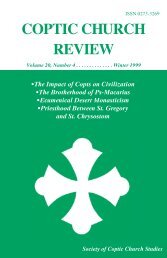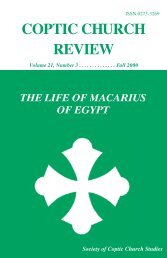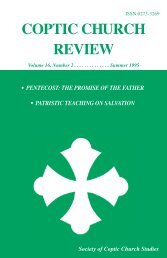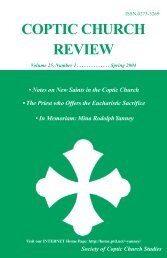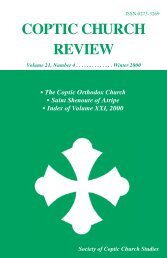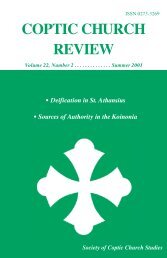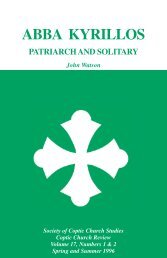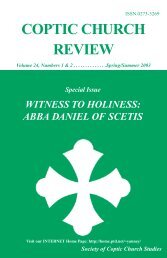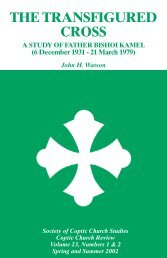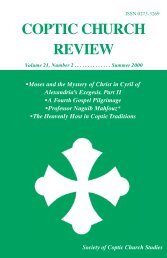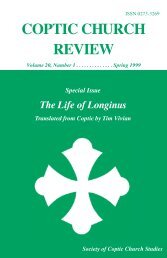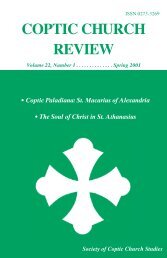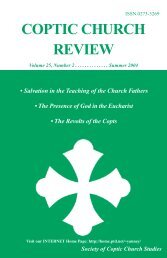2004 Fall.Vol25.#3.pdf - Coptic Church Review
2004 Fall.Vol25.#3.pdf - Coptic Church Review
2004 Fall.Vol25.#3.pdf - Coptic Church Review
You also want an ePaper? Increase the reach of your titles
YUMPU automatically turns print PDFs into web optimized ePapers that Google loves.
68 <strong>Fall</strong> <strong>2004</strong> • <strong>Coptic</strong> <strong>Church</strong> <strong>Review</strong> - Volume 25, Number 3<br />
L’Art Copte en Égypte: 2000 ans de christianisme 10 is the catalogue of the<br />
exhibitions opened in Paris from 15 May to 3 September 2000 and at Cap d’Agde<br />
in Southern France from 30 September 2000 to 7 January 2001. It contains a brief<br />
but important essay Témoignage d’un Peintre Égyptien à Propos des Icônes by<br />
Isaac Fanous, where he offers his testimony concerning the relationship between<br />
the images and the Egyptian character: we may assume that he means the Egyptian<br />
Christian character. 11 The entire catalogue emphasises the perception that <strong>Coptic</strong><br />
Orthodox Christianity was cradled in the culture of pharaonic Egypt, that Egypt<br />
became a major colony of the Roman Empire before the time of Christ and that<br />
there was a Greek inheritance in the intervening period, emphasising a debt to three<br />
cultures. Other noteworthy material about <strong>Coptic</strong> Art can be usually read at the<br />
Institut du Monde Arabe in Paris. 12 A further significant text concerning Christian<br />
iconography in the Middle East is IcÙnes Arabes, art chrÈtien du Levant 13 .<br />
Contributors to this volume include Samir Khalil SJ, who is well known as a visiting<br />
lecturer at the <strong>Coptic</strong> Institute in Abassiya, and Olivier ClÈment, the distinguished<br />
Orthodox author and professor of Eastern Orthodox spirituality in Paris.<br />
This is a catalogue of permanent value for all students of Middle Eastern Christian<br />
art, and there are other eminent contributors. The text has been available in Arabic,<br />
German, French and English. One beautiful French word appears here. That word<br />
is analphabËte and is better than its English-language equivalent. When the catalogue<br />
refers to les analphabËtes, it is translated as ’the illiterates’. But analphabËte<br />
is fashioned from Greek words and a gentler ’without an alphabet’ sounds better<br />
than ‘illiterate‘. The point is that the holy icons, in the world of Late Antiquity and<br />
throughout the later Eastern Christian world, were designed to inform the eyewitness.<br />
The holy images were theologically eloquent. Icons were everywhere. Books<br />
were rare. Frederick Barnard’s famous observation that ‘one picture is worth ten<br />
thousand words’ 14 confirms what many of us have learnt through the holy icons. It<br />
10 L’Art Copte en Égypte: 200 ans de christianisme Editions Gallimard, Paris. 2000.<br />
11 Ibid pp. 239-41.<br />
12 See e.g. Les Coptes; Vingt Siècles de Civilisation Chrétienne en Égypte (Dossiers d’Archeologie No.<br />
226 – September 1997). This collection includes articles on <strong>Coptic</strong> Architecture by Miriam Wissa,<br />
<strong>Coptic</strong> Sculpture by D. Benazeth and an excellent contribution on <strong>Coptic</strong> Monastic iconography by<br />
Paul Van Moorsel. Dossiers d’Archeologie No.233, May 1988 contains an important piece on The<br />
Copts in Fatimid Egypt, using illustrations of the enormous fresco of the Annunciation uncovered in<br />
1991 at Deir es-Souriani by Professor Helmut Buchhausen of the University of Vienna. The English<br />
language publication Egyptian Art at the Louvre (1998. 55084 ISSN 1242-9198, Société Française<br />
de Promotion Artistique) contains a beautifully illustrated essay on <strong>Coptic</strong> Art by Dominique<br />
Bénazeth and Marie-Hélène Rutschowscaya. The IMA also produces its own quarterly journal<br />
Qantara: Magazine des Culture Arabe et Méditerranéenne. Many issues refer to the Middle Eastern<br />
churches: No. 21 Autumn 1996 contains an important feature by Christian Cannuyer on ‘ Christian<br />
Arabs’, including a feature on the Copts. No.35, Spring 2000 is devoted to Les Coptes. In the future<br />
it is likely that the Institut du Monde Arabe will prove to be an interfaith meeting place. It has<br />
already proved to be a major exhibitor of Arab Christian art and iconography.<br />
13 IcÙnes Arabes, art ChrÈtien du Levant (Arab Icons, the Christian Art of the Levant). ISBN 2-<br />
914338-05-8), …ditions GrÈgoriennes.<br />
14 Printers’Ink March 1927.




